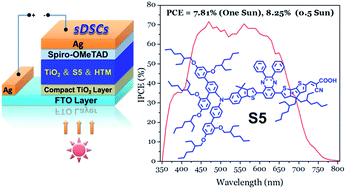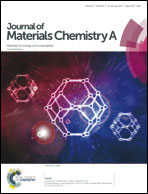High performance solid-state dye-sensitized solar cells based on organic blue-colored dyes†
Abstract
The development of novel photosensitizers with very high molar extinction coefficients and broad absorption spectra to enhance the light harvesting efficiency providing high PCEs for solid state dye sensitized solar cells (sDSCs) is a main target for improvement. In this work, two novel organic blue-colored dyes termed S4 and S5 with indeno[1,2-b]thiophene functionalized triphenylamine as the donor, 2,3-diphenylpyrido[3,4-b]pyrazine (PP) or 2,3-diphenylquinoxaline (QT) as the auxiliary acceptor and cyclopentadithiophene (CPDT) as the π-linker were designed and synthesized for sDSCs. S5 containing the QT unit as the electron-withdrawing group exhibits a high molar extinction coefficient of 6.3 × 104 M−1 cm−1 at 600 nm. Most importantly, the S5-based sDSCs shows record PCEs of 7.81% and 8.25% under one sun and 0.5 sun light intensities, respectively, exceeding the PCE of LEG4-based solar cells (7.34%). To the best of our knowledge, this is the first case where an organic blue-colored dye displays a PCE over 7.8% in sDSCs, thus representing record efficiencies for sDSCs. These results clearly show that molecular engineering is a viable way to develop blue-colored dyes with high molar extinction coefficients for use in highly efficient sDSCs. Also, blue-colored dyes open up co-sensitization strategies in combination with traditional organic dyes with yellow-red colours.



 Please wait while we load your content...
Please wait while we load your content...